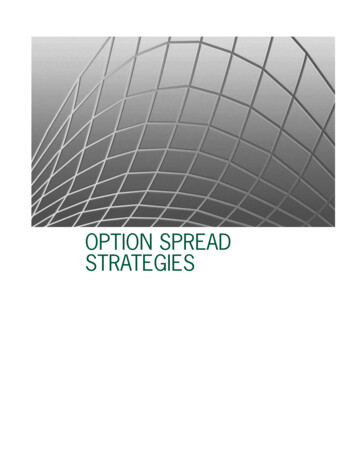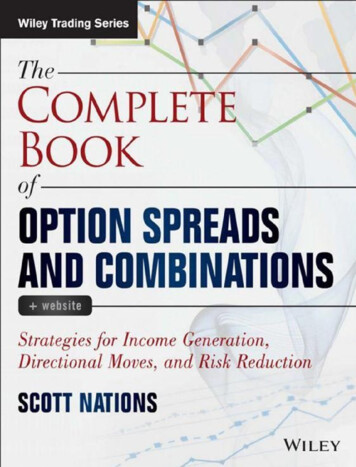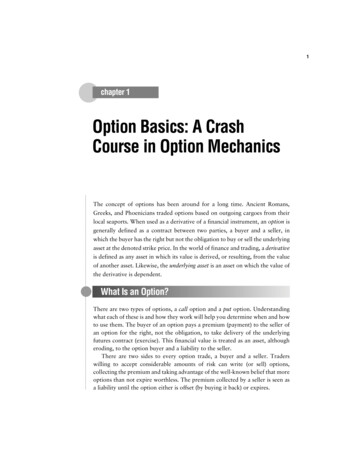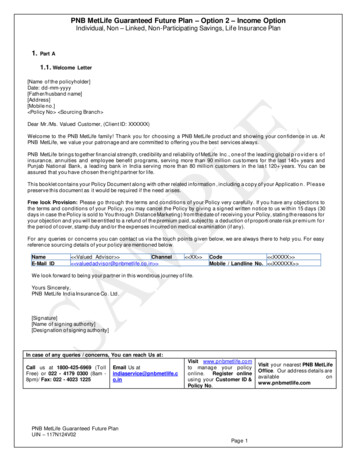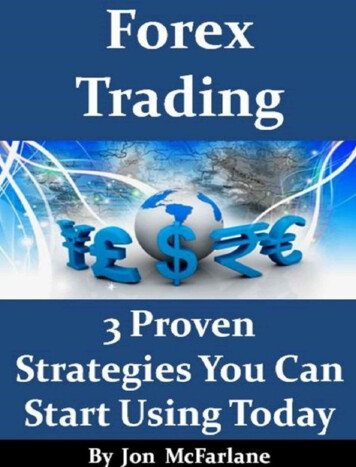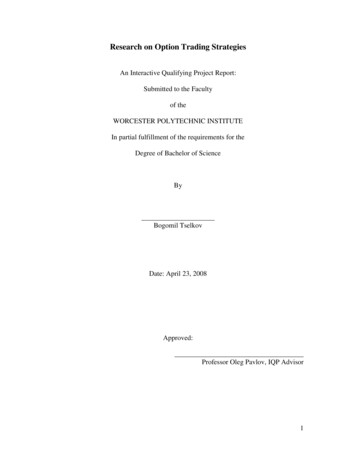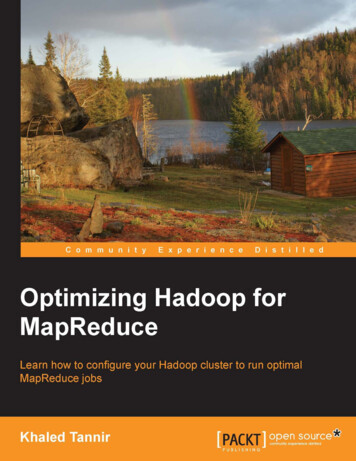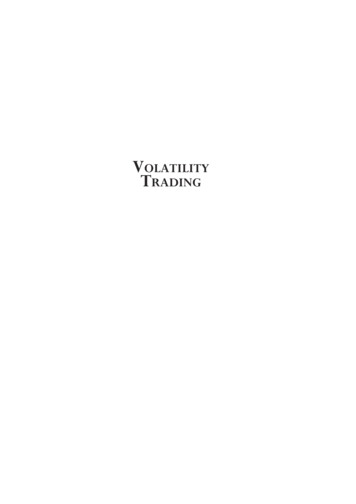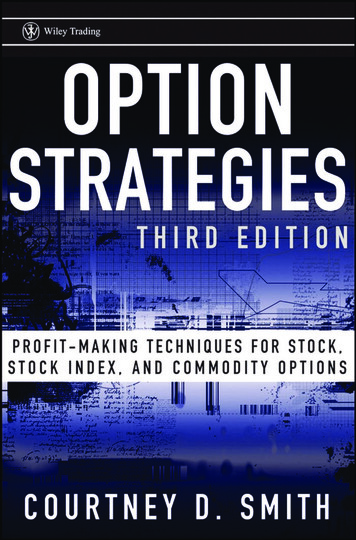
Transcription
FMJWBK147-SmithMay 8, 200810:24Char Count 0OptionStrategiesProfit-Making Techniques forStock, Stock Index, andCommodity OptionsThird EditionCOURTNEY D. SMITHJohn Wiley & Sons, Inc.iii
FMJWBK147-SmithMay 8, 200810:24Char Count 0vi
FMJWBK147-SmithMay 8, 200810:24Char Count 0OptionStrategiesi
FMJWBK147-SmithMay 8, 200810:24Char Count 0Founded in 1807, John Wiley & Sons is the oldest independent publishing company in the United States. With offices in North America, Europe,Australia and Asia, Wiley is globally committed to developing and marketing print and electronic products and services for our customers’ professional and personal knowledge and understanding.The Wiley Trading series features books by traders who have survivedthe market’s ever changing temperament and have prospered—some byreinventing systems, others by getting back to basics. Whether a novicetrader, professional or somewhere in-between, these books will providethe advice and strategies needed to prosper today and well into the future.For a list of available titles, please visit our web site at www.WileyFinance.com.ii
FMJWBK147-SmithMay 8, 200810:24Char Count 0OptionStrategiesProfit-Making Techniques forStock, Stock Index, andCommodity OptionsThird EditionCOURTNEY D. SMITHJohn Wiley & Sons, Inc.iii
FMJWBK147-SmithMay 8, 200810:24Char Count 0C 1996, 2008 by Courtney D. Smith. All rights reservedCopyright Published by John Wiley & Sons, Inc., Hoboken, New JerseyPublished simultaneously in CanadaNo part of this publication may be reproduced, stored in a retrieval system, ortransmitted in any form or by any means, electronic, mechanical, photocopying,recording, scanning, or otherwise, except as permitted under Section 107 or 108of the 1976 United States Copyright Act, without either the prior writtenpermission of the Publisher, or authorization through payment of the appropriateper-copy fee to the Copyright Clearance Center, Inc., 222 Rosewood Drive,Danvers, MA 01923, (978) 750-8400, fax (978) 750-4470, or on the web atwww.copyright.com. Requests to the Publisher for permission should beaddressed to the Permissions Department, John Wiley & Sons, Inc., 111 RiverStreet, Hoboken, NJ 07030, (201) 748-6011, fax (201) 748-6008, or online athttp://www.wiley.com/go/permissions.Limit of Liability/Disclaimer of Warranty: While the publisher and the authorhave used their best efforts in preparing this book, they make no representationsor warranties with respect to the accuracy or completeness of the contents ofthis book and specifically disclaim any implied warranties of merchantability orfitness for a particular purpose. No warranty may be created or extended bysales representatives or written sales materials. The advice and strategiescontained herein may not be suitable for your situation. You should consult witha professional where appropriate. Neither the publisher nor the author shall beliable for any loss of profit or any other commercial damages, including but notlimited to special, incidental, consequential, or other damages.For general information on our other products and services or for technicalsupport, please contact our Customer Care Department within the United Statesat (800) 762-2974, outside the United States at (317) 572-3993 or fax (317)572-4002.Wiley also publishes its books in a variety of electronic formats. Some contentthat appears in print may not be available in electronic books. For moreinformation about Wiley products, visit our web site at www.wiley.com.Library of Congress Cataloging-in-Publication Data:Smith, Courtney.Option strategies : profit-making techniques for stock, stock index, andcommodity options / Courtney D. Smith. – 3rd ed.p. cm.Includes index.ISBN 978-0-470-24779-2 (cloth)1. Financial futures. 2. Options (Finance) 3. Commodity options. I. Title.HG6024.3.S55 2008332.64 53–dc222008014647Printed in the United States of America10 9 8 7 6 5 4 3 2 1iv
FMJWBK147-SmithMay 8, 200810:24Char Count 0To Pamv
FMJWBK147-SmithMay 8, 200810:24Char Count 0vi
FMJWBK147-SmithMay 8, 200810:24Char Count 0ContentsPrefaceCHAPTERPART ONEix1 IntroductionWhy and How Option Prices Move157CHAPTER2 The Fundamentals of OptionsCHAPTER3 The Basics of Option Price Movements21CHAPTER4 Advanced Option Price Movements39CHAPTER5 Volatility59PART TWO Option Strategies73CHAPTER6 Selecting a Strategy75CHAPTER7 Buy a Call91CHAPTER8 Buy a Put103CHAPTER9 Naked Call Writing115CHAPTER 10 Covered Call Writing123CHAPTER 11 Ratio Covered Call Writing143CHAPTER 12 Naked Put Writing151vii
FMJWBK147-SmithMay 8, 200810:24Char Count 0viiiCONTENTSCHAPTER 13Covered Put Writing159CHAPTER 14Ratio Covered Put Writing175CHAPTER 15Bull Spreads183CHAPTER 16Bear Spreads197CHAPTER 17Butterfly Spreads209CHAPTER 18Calendar Spreads225CHAPTER 19Ratio Spreads233CHAPTER 20Ratio Calendar Spreads245CHAPTER 21Straddles and Strangles249CHAPTER 22Synthetic Calls and Puts267CHAPTER 23Synthetic Longs and Shorts271CHAPTER 24How to Make Money Trading Options275Index301About the Author307For More Information309
FMJWBK147-SmithMay 8, 200810:24Char Count 0Prefacebout 20 years ago I approached John Wiley & Sons with the idea towrite a guide to option strategies. Several books had been writtenthat gave an overall introduction to options and too many bookshad been written that purported to show the reader how to make millionswhile sipping pina coladas on the beach. No book had been written purelyon options strategies. Wiley decided to give it a go.Twenty years and one edition later, the book is still being sold acrossthe country. Few books live that long! I want to thank my readers for theirsupport.This third edition adds much more information on predicting impliedvolatility, how to select a strategy, and how to make money trading options.In addition, more material has been added to just about every chapter. And,of course, I’ve cleaned up even more errors. Thanks to my eagle-eyed readers for spotting them!One thing I have tried to retain from the first edition is the straightforward approach to options strategies. This book is designed to be used bytraders, not read by rocket scientists. I have attempted to keep the math toa bare minimum. There are now plenty of books with plenty of formulas.The success of this book is gratifying. But the most gratifying successcomes from helping you, the reader, make money in the markets. I hopethis book helps you to be a trading success.Aix
FMJWBK147-SmithMay 8, 200810:24Char Count 0x
c01JWBK147-SmithApril 25, 20087:26Char Count CHAPTER 1Introductionelcome to the third edition of Option Strategies. This book willtake you on a guided tour of the world of option strategies.Options present the investor with a myriad of new strategies.Some are very conservative, such as covered call writing, whereas othersare very speculative, such as naked call selling. Options provide more andoften better ways to fine-tune your investing strategies to expected marketconditions.This book covers all types of options: stock index, stock, and commodity. Bullish and bearish strategies are covered equally. It will be useful toall options traders and hedgers, from novices to professionals.WDECISION STRUCTURESA decision structure is an ordered line of inquiry, consisting of a structuredseries of situations and choices that assist you in analyzing potential tradesand in determining your course of action after you have entered a trade. Adecision structure is not an exhaustive compilation of all possible strategies but a concise guide to the analysis necessary to deal with the mostcommon possibilities.1
c01JWBK147-SmithApril 25, 20087:26Char Count 2INTRODUCTIONIn order to achieve your objectives, you must first identify your objectives. This self-evident truth is often forgotten. Two main questions canhelp you:1. How much risk are you willing to take? Each person has a subjectivecriterion of risk. You must have an idea of the level of risk with whichyou are comfortable so that you can make acceptable investments.2. What kind of return do you need to take on that level of risk? Thegreater the risk, the greater should be your prospective reward. Lookat competing investments. You might have found a low-risk coveredwrite, but your return might be just above Treasury bills. Why botherwith such a trade? Look for those opportunities that have significantlymore reward, though they also have more risk.SIMPLIFICATION OF OPTIONSCALCULATIONSMost discussions of options calculations are too simple. They highlightthe important issues rather than present seemingly irrelevant information.However, in the final analysis, reality is complex.The major area of simplification has been in the mathematics of options. In general, the calculations given in books and articles have ignoredsuch factors as transaction costs, carrying charges, and taxes. In mostcases, this is not critical. However, there is no need to invest in an optiontrade and lose money because of ignored factors.The discussions of risk and reward in Chapters 7 to 24 focus on thestrategy and usually do not mention carrying charges, unless carryingcharges tend to be a major determinant of profitability. For example, carrying charges are rarely going to affect the decision to buy a call, but anarbitrage between an underlying instrument and a reverse conversion isdominated by considerations of carrying charges.CARRYING CHARGESCarrying charges, including transaction costs, the bid/ask spread, slippage, and financing costs, must always be considered when deciding on astrategy.Transaction costs are an ever-present cost of trading. The term transaction costs includes commissions, the bid/ask spread, and slippage. Typically, the largest transaction cost is brokerage commissions. Brokeragehouses charge commissions on all transactions. Many option strategiesinvolve the use of options in conjunction with other instruments. For
c01JWBK147-SmithIntroductionApril 25, 20087:26Char Count 3example, a covered call write program in stocks involves the sale of a callagainst the purchase of the underlying stock. The commission on the stockpurchase and on the eventual sale should be considered in the investmentdecision.Traders of options on the floors of the various exchanges do not needto consider this factor as much. Their transaction costs are pennies percontract.Another potential transaction cost is the bid/ask spread of the investment. (The bid is the highest price that someone is willing to pay for theoption; the ask is the lowest price at which someone is offering to sell theoption.) All options and related instruments have a bid/ask spread. For example, an option may have a last price of 41 /4 , but the bid may be 41 /8 andthe ask may be 43 /8 . In general, most investors will have to pay the ask tobuy an option, and will sell at the bid price. This has the effect of inducingslippage in calculations of profits, risks, and break-evens. It is usually wiseto include at least one minimum tick or price movement into the costs ofyour option trade. For example, bond futures options trade in units of 1 /64 .It would be a good idea to subtract 1 /64 from your expected sale price andadd 1 /64 to your expected purchase price.The bid/ask spread is a major source of profit for floor traders. Theytypically look to buy at the bid and sell at the ask. This enables them toexecute many strategies that cannot be executed by everybody else. Suchstrategies as conversions, butterflies, and reversals tend to be the exclusivedomain of professional floor traders. These strategies tend to be dominatedby transaction costs. The ability to buy at the bid and sell at the offer is apowerful advantage in trading these strategies.Slippage is the final transaction cost and is related to the bid/askspread. It is the difference between the price that you expect on the fillof an order and the actual cost. For example, you could expect to get a fillat 17 /8 on a purchase of a call, but the market is active and volatile and yourorder is not filled until the market is up to 21 /8 . Very conservative investorsshould include at least another tick on the expected price as slippage forcomputing expected returns on a trade.Carrying charges, often overlooked and/or idealized, represent thecosts to carry an open position. Traders should at least consider the opportunity cost of initiation and carrying a particular trade. There are aninfinite number of investment possibilities. When you decide to do an option trade, you have implicitly rejected all other investment possibilities.You have eliminated the opportunity to invest elsewhere. Traditionally, theopportunity cost has been quantified as the Treasury-bill rate because it isconsidered riskless.Leveraged positions have a finance charge. This finance charge mustbe considered before initiating a position and while calculating the
c01JWBK147-SmithApril 25, 20087:264Char Count INTRODUCTIONpossible outcomes. For example, a covered write against a stock boughton 50 percent margin will have the profit potential reduced by the financingcharges. The term carrying charges or carrying costs is used throughoutthis book as a shorthand reference to the various costs associated withcarrying a trade or position.The biggest cost of all is probably taxes. This book assumes no taxeson any of the trades when making the various calculations. However, thereader should definitely consider the tax consequences of their trades. Thiscould have a major impact on the long-term efficacy of the trading program.OVERVIEW OF THE BOOKThe book is divided into two parts. The four chapters of Part One outline the fundamentals of options. This part forms a base for the remainderof the book. Even experienced options traders should scan these chaptersto make sure they are using the same terminology as is found in this book.Part Two contains Chapter 6, which outlines several of the considerations that are important in selecting a st
take you on a guided tour of the world of option strategies. Options present the investor with a myriad of new strategies. Some are very conservative, such as covered call writing, whereas others are very speculative, such as naked call selling. Options provide more and often better ways to fine-tune your investing strategies to expected market
